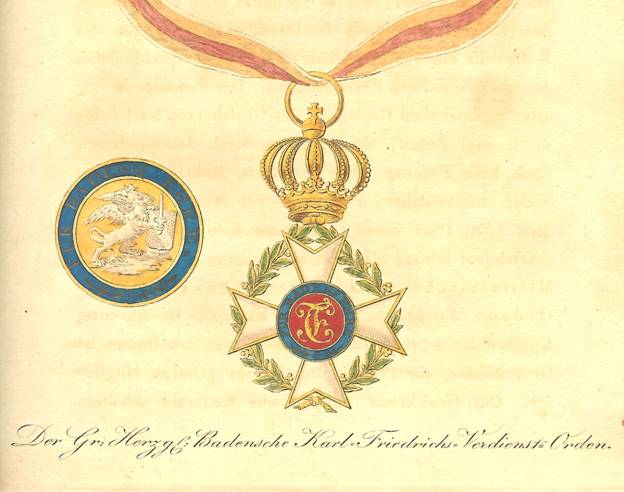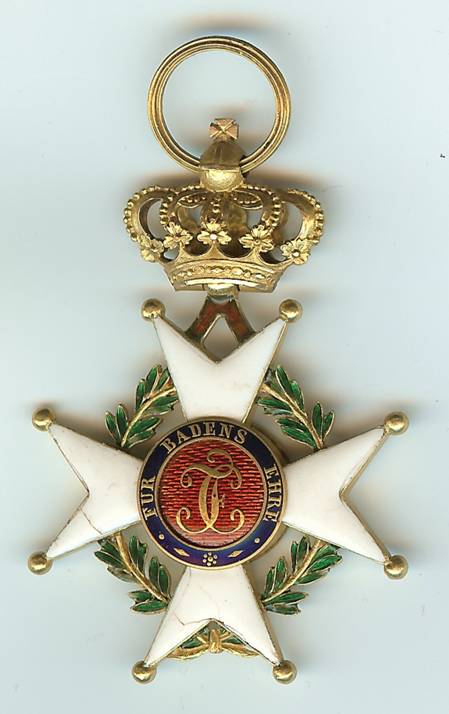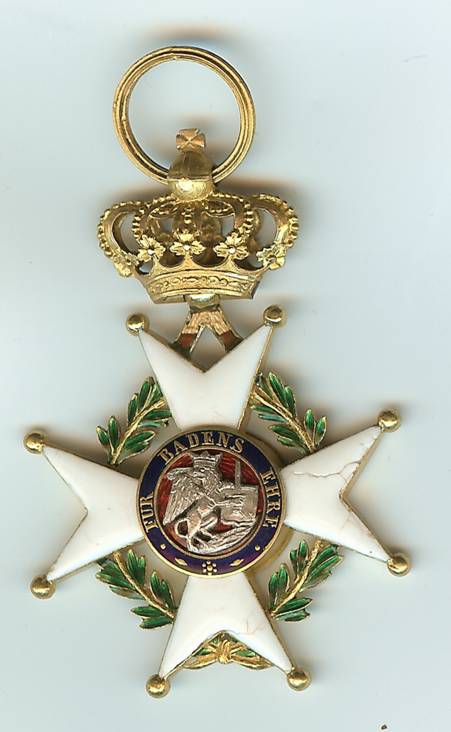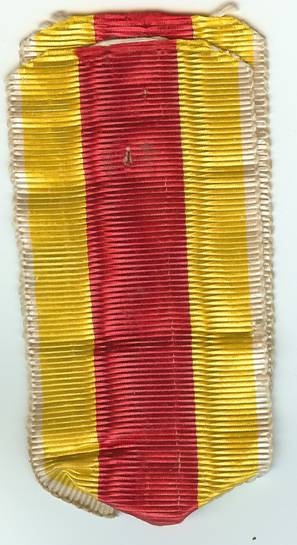|
Lorin
E. Stapleton
In May of 2006, the auction firm
Morton & Eden Ltd. of
London
sold an offering of Orders and medals which had been
part of the American Numismatic Society Collection.
One such item was lot number 618, a Grand Duchy
of Baden Military Karl Friedrich Merit Order Knight’s
Cross, which attracted little serious attention amongst
the other spectacular items which were offered.
Unfortunately, no information regarding the means
by which the American Numismatic Society obtained this
particular item was available in the catalogue.
The piece was probably dismissed as
a modern “copy” by most prospective bidders, as it
did not exactly match any of the known examples of
Military Karl Friedrich Merit Order Knight’s Crosses.
In the 1817 Almanach
der Ritter=Orden by Friedrich Gottschalck is a plate
with a faithful representation of how the Order was
designed to appear.
This work was published ten years after the Order
was founded in 1807.

Figure
1: Military Karl Friedrich Merit Order illustration from
1817.

Figure 2:
Ex-American Numismatic Society Collection Military Karl
Friedrich Merit Order Knight’s Cross Obverse.
Analysis of the design, workmanship,
possible country of origin, and the possible date of
manufacture of the Ex-American Numismatic Society piece
The ex-American Numismatic Society
piece has some distinct differences which are readily
apparent when compared to the early illustration.
The design variations would suggest that the
piece was not made by a German jeweler under official
contract by the Grand Duchy of Baden.
The first feature that is strikingly apparent is that
the ex-ANS piece has small spheres at the end points of
the cross arms. This
feature is noted on French Honor Legion Order pieces
made after 1815. It
should be noted that prior to this period, Honor Legion
Order pieces did not have this feature.
The small spheres were added to minimize the
snagging of the arm tips on clothing, and to minimize
chipping of the enamel of the Order if knocked against a
hard object. This
change was therefore made out of necessity to improve
the “wearability” and durability of the Order.
Another notable difference is that
the ex-ANS piece has two plain red-enameled supports
connecting the crown to the body of the cross, instead
of continuations of the laurel-wreath branches to form
supports for the crown.
The red enamel is translucent over a hand-tooled
guilloche pattern. This
type of variation is also found on Honor Legion badges
from various eras. The
laurel-wreath branches do not appear at the ends of the
horizontal cross arms on the ex-ANS piece.
A third interesting feature of note
is the fused grooved ribbon ring.
This type of ribbon ring is consistent with
examples found on early 19th Century Orders
of French manufacture.
The three design variations listed
above point to the possibility of the piece having a
French influence regarding design and manufacture.
There are also other subtle design
variations that make this piece unlike the
“official” design.
The laurel branches have no red berries, which is
a feature that was faithfully included in all other
existing representations of the Order that I have seen.
Further, at the bottom of the medallion rings,
there are floral ornamentations consisting of seven
dots, two lozenges at the sides of these, and two dots
at the outer sides of these.
Two laurel sprays are usually found in this
position on the medallion rings.
The workmanship of the piece is
also consistent with other Orders made in
France
(and other European countries) during the early 19th
Century. On
the obverse center, the translucent red enamel covers a
hand-tooled horizontal guilloche pattern.
The “C F” cipher was hand-applied in gold
foil on top of the underlying enamel.
This is a similar technique to the lettering
applied to contemporary Prussian Pour le Mérite Orders.
The crown is hinged so that it can swivel.
Some of the features of the crown are
hand-chased, as are features of the binding and laurel
branches underneath the lower cross arm.

Figure 3:
Ex-American Numismatic Society Collection Military Karl
Friedrich Merit Order Knight’s Cross Reverse.
The reverse center features a
hand-tooled griffin in silver, separately applied to the
center. Behind
the griffin application, is translucent red enamel, over
a circular hand-tooled guilloche pattern.
The cross body is made of an alloy
with a very high gold content.
There are no hallmarks or maker’s marks found
on this piece. The
absence of hallmarks is not typical for a piece of
French manufacture, but it does not exclude the
possibility of French origin altogether.
The cross is 37mm wide and 55mm high (excluding
the ribbon ring). The
cross weighs 15.0g.
The ribbon that accompanied this
piece is made of silk, is 33mm in width, and is of the
proper colors and pattern.
The ribbon is not from the early 19th
Century however, and was manufactured at a later date
(prior to 1918). This
is apparent due to the fineness of the silk weave.
Earlier ribbons usually had a coarser weave, as
refinements in looms used in the manufacturing of
ribbons did not allow for such quality until much later.
It is therefore assumed that this ribbon was
added to the piece at a later time than when it was
manufactured. Such
an addition could have been made by the recipient later
in life, or by a collector.

Figure 4:
Ex-American Numismatic Society Collection Military Karl
Friedrich Merit Order Knight’s Cross ribbon.
French recipients of the Military Karl
Friedrich Merit Order Knight’s Cross
All of the factors regarding the
design and manufacturing methods used for this piece, as
noted above, are consistent with pieces of French origin
from the early 19th Century.
To explore the possibility of French origin
further, we now examine the awards made to French
recipients in the early 19th Century.
|
Year
|
Total
number of awards
|
|
1807
|
5
|
|
1808
|
8
|
|
1809
|
11
|
|
1810
|
3
|
|
1812
|
3
|
|
1814
|
4
|
|
1818
|
1
|
|
1819
|
1
|
|
1845
|
1
|
Table
1: Awards of Military Karl Friedrich Merit Order
Knight’s Crosses to French Officers from 1807 until
1857.
A total of 30 awards were made from
1807 until 1812, when the Grand Duchy of Baden was part
of the Confederation of the
Rhine
. There were four awards made in 1814, just prior to the
Grand Duchy of Baden joining the German Confederation in
1815. Also, from 1815 until 1857, there were only three
awards. In
total therefore, there were only 37 awards of Knight’s
Crosses to French Officers during this period.
It should be noted, that Knight’s Cross awards
to foreign officers (from non-German states) also
included awards made to Austrian Officers (15), and to
Russian Officers (36) during this period.
However, analysis of the design features and
workmanship of this piece, as noted above, make the
possibility of Austrian or Russian origin unlikely.
Manufacturing of foreign Orders by early
19th century jewelers
During the early 19th
Century, an officer who was awarded an Order by a
foreign government would possibly only receive a
notification of such an award in the form of a letter
and/or a bestowal document.
It was then up to the recipient to contact a
local jeweler to contract to have a representation of
the Order in question manufactured at their cost.
The jeweler then had to either look in existing
publications or pattern books to see what the Order was
supposed to look like.
Or, if no illustration was available, they had to
rely on a written description.
The jeweler would then use the methods and skills
that they were familiar with in manufacturing the piece.
Such a process would account for variations of
design in surviving foreign-made Orders.
In fact, each piece made under these
circumstances was probably unique.
In summary, this piece appears to
have been made by a French jeweler, and to have been
made in the early 19th Century.
It was probably a piece contracted for
manufacture by one of the 37 French recipients noted
above. A
piece such as this is almost certainly unique, and
although it is technically a “copy”, it is of
historical significance.
References:
Gottschalck,
Friedrich. Almanach
der Ritter=Orden. Georg Joachim Goeschen.
Leipzig
, 1817.
Morton & Eden
Ltd. Auction 19,
Medals, Orders and Decorations from the Collection of
the American Numismatic Society: Part 1. http://www.mortonandeden.com/pdfcats/19web.pdf
(21November 2007).
Zelosko, Frank. Für
Badens Ehre, Militärischer Karl=Friedrich=Verdienstorden
und Verdienstmedaille, 1807-1918, Erster Band. Frank
Zelosko. Mosbach, 2003.
Copyright
© Lorin E. Stapleton 2007
| 




